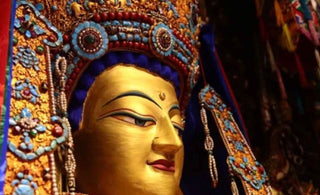
In the realm of Tibetan Buddha statues, a profound transformation is underway, marked by the marriage of tradition and the spirit of the contemporary age. The confluence of ancient symbolism and modern sensibilities has given rise to a fascinating array of sculptures that resonate with both cultural heritage and the evolving ethos of the present. As artists and artisans navigate this delicate dance between tradition and innovation, Tibetan Buddha statues have become not just artifacts of veneration but living embodiments of a culture in dialogue with the contemporary world.
Contemporary perspectives on Tibetan Buddha statues are grounded in a deep respect for tradition but infused with a dynamic spirit that seeks relevance in the present. One striking example of this fusion is the work of Tenzin Rigdol, a visionary artist whose creations reflect a profound engagement with both the timeless narratives of Tibetan Buddhism and the urgencies of the contemporary moment. Rigdol's sculptures, often monumental in scale, become contemporary totems that bridge the spiritual and the secular.
In Rigdol's hands, the traditional iconography of Tibetan Buddha statues undergoes a metamorphosis. The serene countenance of the Buddha, instead of being a static representation, becomes a mirror reflecting the complexities of the modern human experience.
In Rigdol's "Awakening Mind" series, the serene visage of the Buddha becomes a canvas for a dialogue between tradition and the urgencies of the present. Traditional iconography seamlessly blends with fragments of newspaper articles, technological circuitry, and symbols of the contemporary era. The once tranquil face becomes a reflective surface, inviting viewers to contemplate the intricate interplay between timeless wisdom and the challenges of the modern age. The static gives way to the dynamic as the Buddha's countenance mirrors the changing landscapes of our collective consciousness.
This metamorphosis in the representation of the Buddha transcends artistic expression; it becomes a philosophical exploration of the timeless teachings in the context of contemporary issues. The serene countenance, now a mirror, not only captures the viewer's reflection but also projects a nuanced understanding of the complexities that define our human experience. It serves as a visual commentary on the evolving nature of spirituality, urging individuals to engage with the teachings in a way that is relevant to their lives.
The shift from a static representation to a reflective mirror in contemporary Tibetan Buddha statues signifies a departure from the conventional towards a more dynamic and inclusive interpretation of Buddhist art. This transformation invites a broader audience to connect with the spiritual essence encapsulated in these statues, fostering a meaningful dialogue between tradition and the ever-evolving landscape of the human journey. As the Buddha's countenance mirrors the intricate tapestry of contemporary existence, it invites us to explore the intersections of spirituality and modernity, offering a profound reflection on the timeless wisdom embedded in these sacred sculptures.
The choice of materials in contemporary Tibetan Buddha statues also reflects a departure from traditional norms. While bronze and wood remain integral, artists now explore unconventional mediums, including recycled materials, glass, and even digital platforms. This departure from convention is not a rejection of tradition but a creative reinterpretation that seeks to engage with a diverse audience. The "Digital Dharma" project by artist Dawa Tarchin Phillips, for instance, involves the creation of digital Buddha statues accessible through virtual reality, blending ancient spirituality with cutting-edge technology.
Moreover, contemporary artists are attuned to the need for diversity and representation in Buddhist iconography. Traditional Tibetan statues often depict male figures, but modern interpretations increasingly include representations of female Buddhas, and diverse forms of enlightened beings. This inclusive approach aligns with contemporary values of diversity and gender equality, challenging traditional norms and expanding the narrative scope of Tibetan Buddhism.
The digital age has also ushered in new ways of engaging with Tibetan Buddha statues. Online platforms, virtual exhibitions, and digital installations provide a global audience with access to the rich tapestry of Tibetan Buddhist art. This democratization of access ensures that the spiritual teachings embedded in these statues reach beyond geographical boundaries, fostering a global appreciation for the profound wisdom encapsulated in Tibetan Buddhism.
As Tibetan Buddha statues embrace the present, they become not only objects of devotion but also catalysts for dialogue. Contemporary perspectives invite individuals to explore the intersections of spirituality and modernity, challenging preconceived notions and fostering a dynamic engagement with the profound teachings encapsulated in these sculptures. The fluidity between tradition and contemporary expression reflects not a rupture with the past but a vibrant evolution, ensuring that Tibetan Buddha statues remain timeless conduits of wisdom in an ever-changing world.

19th Century Padmasambhava Tibetan Antique Buddha Statue Full of Gilt From Kathok Monastery
























